E-Waste (Electronic Waste) refers to smartphones,
laptops, home appliances, and other devices that are no longer in use. In this
column, we’ll rethink the value of e-waste through the example of the Tokyo
Olympic gold medals, and we’ll explain in simple terms how the volume of
e-waste is surging globally each year and what environmental risks it poses.
―
The Truth Revealed by the Tokyo Olympic Gold Medals
―

In
2017, Japan launched a project that stunned the world: they decided to make
every gold, silver, and bronze medal for the 2020 Tokyo Olympics out of metals
recovered from electronic waste.
By
collecting 62.1 million discarded electronic devices from across Japan, they
extracted 30 kg of gold, 4,100 kg of silver, and 2,700 kg of copper. From these
materials, they produced a total of 5,000 medals (Source: Tokyo 2020 Medal
Project Final Report, 2021).
This
project went beyond simple recycling. It demonstrated that the smartphones and
laptops we readily discard are actually repositories of precious resources. At
the same time, it prompted us to reflect on just how frequently—and how
easily—we throw away our electronic devices.
―
What Is Electronic Waste?
―

(Source: ©Clean Management. https://cleanmanagement.com/blog/4-common-e-waste-disposal-methods-to-know/)
Electronic
waste (E-Waste) refers to any electronic device that has reached the end of its
lifespan or has broken down, including smartphones, laptops, televisions, and
printers, as well as e-cigarettes, digital watches, and gaming consoles.
Inside
these devices are rare metals like gold (Au), silver (Ag), cobalt (Co), and
lithium (Li), along with hazardous substances such as lead (Pb), mercury (Hg),
and cadmium (Cd). If e-waste is discarded carelessly, it can lead to
environmental pollution and health problems.
▶ Quick summary:
- E-Waste encompasses all discarded electronic devices.
- Contains both hazardous materials and valuable rare metals.
- If not properly recycled, it poses serious environmental and health risks.
The
United Nations University (UNU) warns that e-waste is “one of the
fastest-growing solid waste streams on the planet,” and that failing to manage
it properly could threaten a sustainable future.
―
What Is the Current State of E-Waste?
―
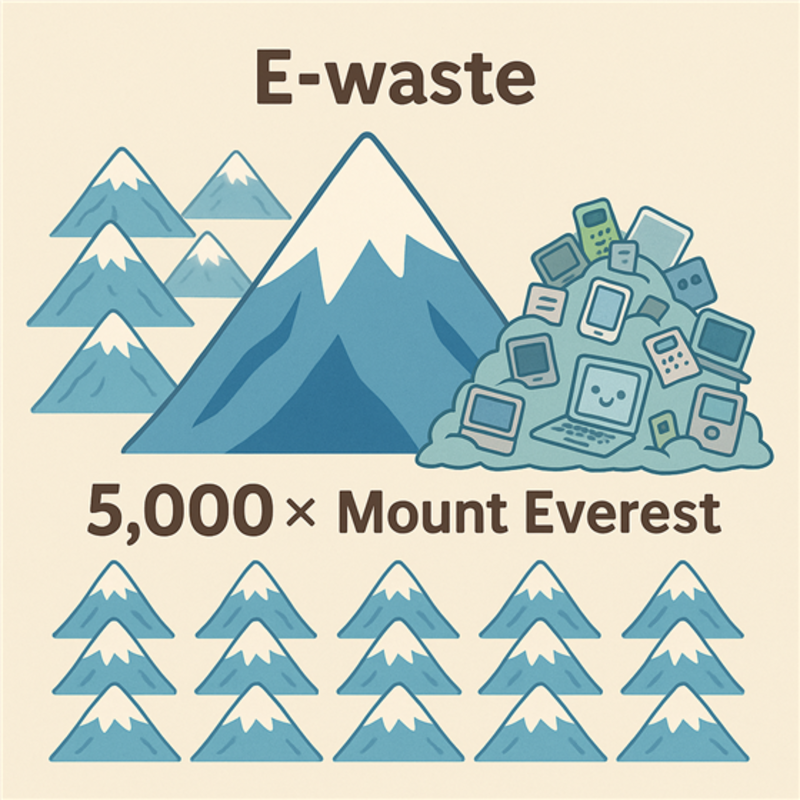
According
to UNU’s 2020 report, the world generated a staggering 53.6 million metric tons
of e-waste in 2019. That’s equivalent to stacking Mount Everest more than 5,000
times over. On average, each person discarded about 7.3 kg of e-waste that
year.
Asia
produced the most—24.9 million t—followed by the Americas with 13.1 million t,
Europe with 12 million t, Africa with 2.9 million t, and Oceania with 0.7
million t.
What’s
even more shocking is that only 17.4 percent of that e-waste was recycled. The
rest ended up in landfills or was exported illegally to developing countries.
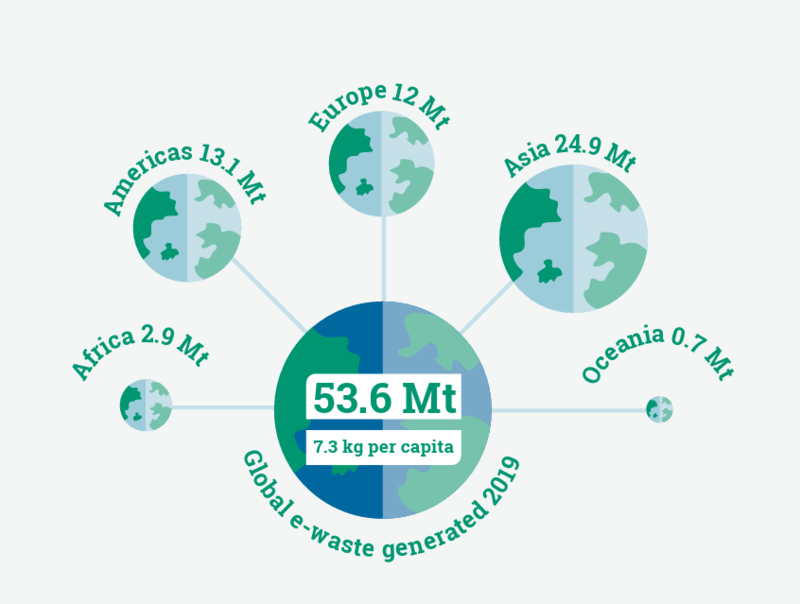
(Source: ©E-Waste Monitor. The Global E-Waste Monitor 2020, https://ewastemonitor.info/gem-2020/)
▶Quick summary: E-Waste by
the numbers
- Total e-waste in 2019: about 53.6 million t (7.3 kg per person)
- By region: Asia 24.9 million t, Americas 13.1 million t, Europe 12 million t, Africa 2.9 million t, Oceania 0.7 million t
- Annual increase in electronics consumption: roughly 2.5 million t per year
- Post-2021 growth rate: about 4 million t extra per year
―
Why Is E-Waste Increasing?
―
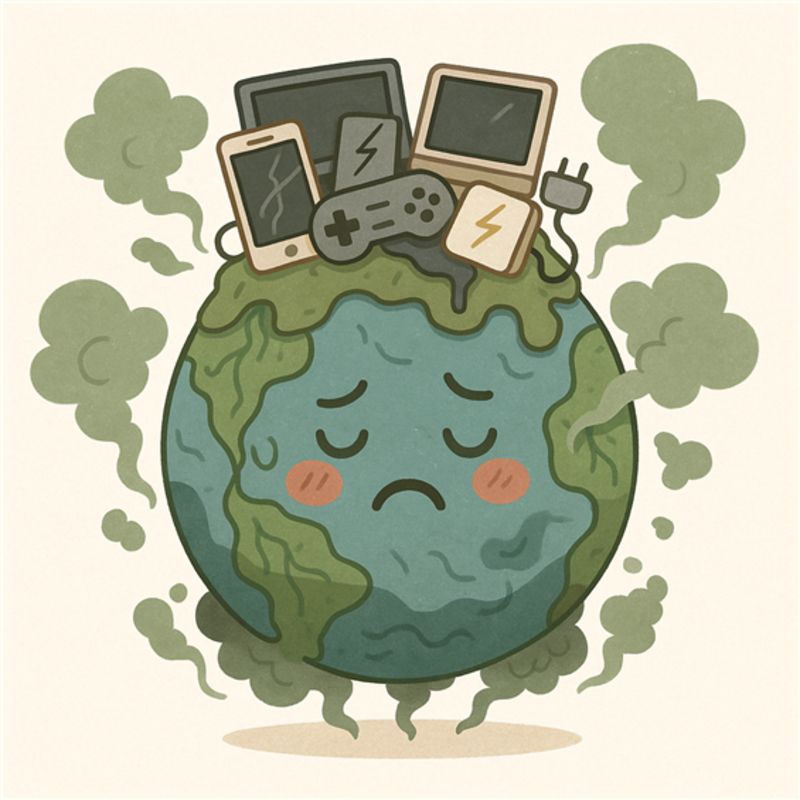
It’s
not just technology at fault; it’s also our social structure and consumption
habits.
As
incomes rise, people buy new electronics more frequently. Urbanization drives
up demand—more people in cities means more essential gadget usage. Meanwhile,
industrialization has increased production capacity. As a result, electronics
consumption has grown by an average of 2.5 million t per year.
But
the bigger issue is not “how much we buy” but “how quickly we dispose of it.”
Smartphones and laptops are designed with short lifespans and are difficult to
repair. Repair costs are high, and repair shops are scarce. Devices that are
short-lived and hard to fix accelerate the growth of e-waste.
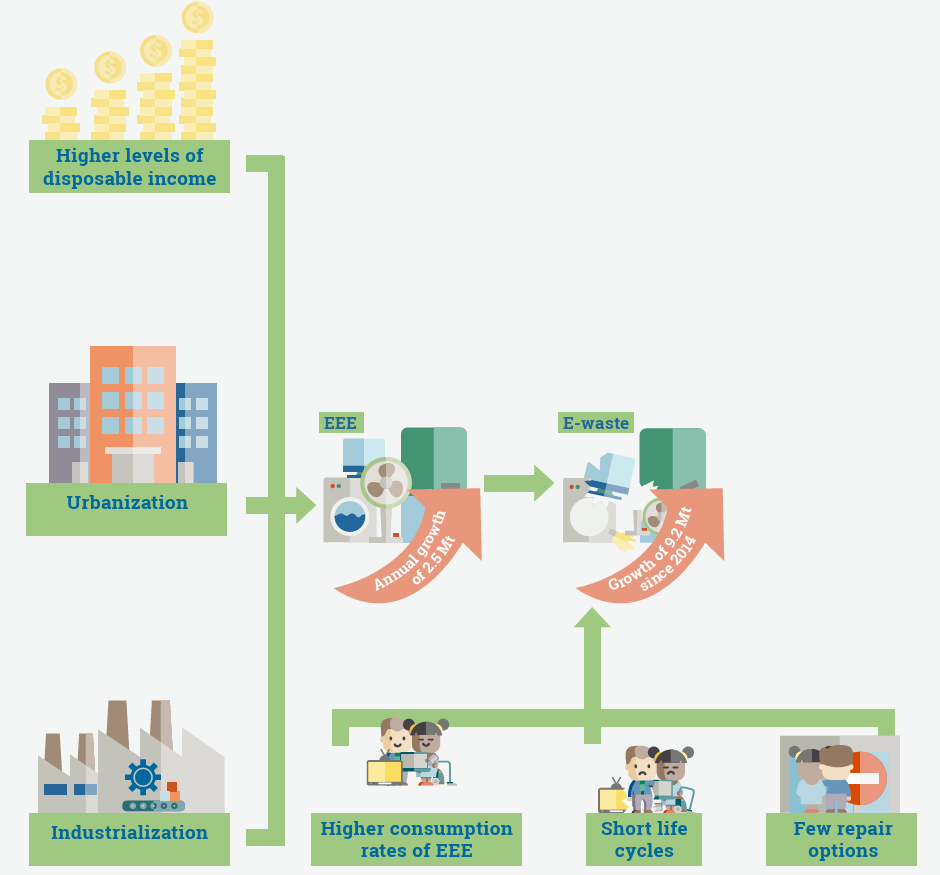
(Source: ©E-Waste Monitor. The Global E-Waste Monitor 2020, https://ewastemonitor.info/gem-2020/)
▶ Quick summary: Causes of
rising e-waste
1. Income growth:
People buy more
electronics.
2. Urbanization:
More city dwellers
leads to higher electronics usage.
3. Industrialization:
More factories
producing devices, with faster product cycles.
4. High consumption rates:
Many people now own
multiple electronic devices.
5. Short lifespans:
Smartphones and laptops
often get replaced after just 1–2 years.
6. Difficulty of repair:
Devices are engineered
to be hard to fix, and repair services are limited.
Solving
these issues requires more than just urging people to “buy less.” It demands a
comprehensive shift: designing products for easy repair from the start,
policies that help consumers fix devices affordably, and greater corporate
responsibility.
―
How Much E-Waste Will There Be?
―

(Source: ©E-Waste Monitor. The Global E-Waste Monitor 2020, https://ewastemonitor.info/gem-2020/)
E-Waste
rose from 44.4 Mt in 2014 to 53.6 Mt in 2019. It’s projected to reach 63.3 Mt
in 2024 and a staggering 74.7 Mt by 2030. Per capita e-waste is expected to
climb from 6.4 kg to 9.0 kg in that same period.
This
increase isn’t solely because we use more electronics—it’s because we replace
them so quickly. In an era where swapping smartphones every 1–2 years is
normal, the underlying waste problem grows far larger than imagined.
Within
the next decade, e-waste will be over 1.5 times greater than today’s levels.
What can we do? A good starting point is to ask ourselves before buying a new
device: “Do I really need this?”
―
The Impact of a Single Smartphone
―
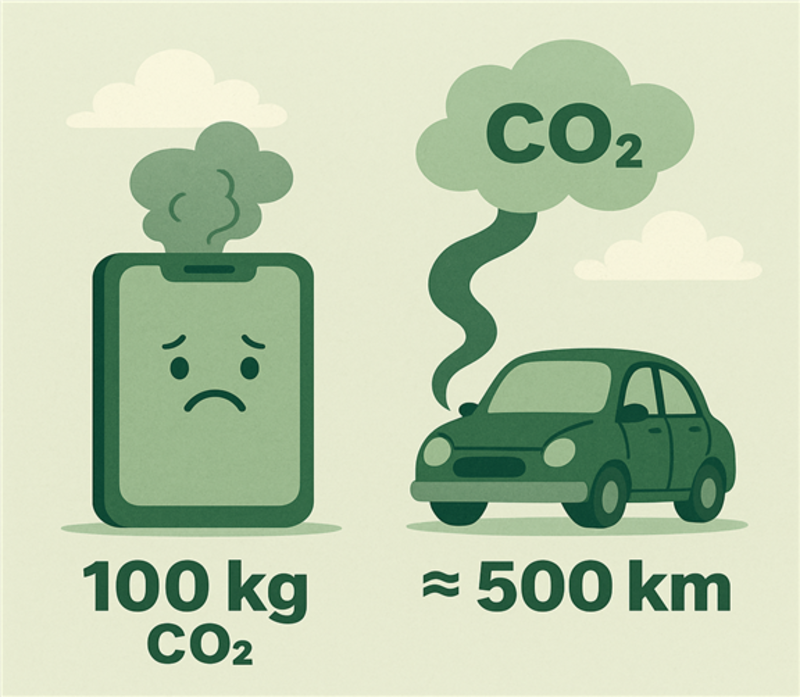
(Source: ©Greenpeace. https://www.greenpeace.org/usa/from-smart-to-senseless-the-global-impact-of-ten-years-of-smartphones/)
Producing
one smartphone emits an average of 100 kg of CO₂—roughly the same as driving a
car about 500 km (Source: Greenpeace, “From Smart to Senseless,” 2017).
So
why are emissions so high?
- Rare-metal mining:
Extracting lithium, cobalt, gold, etc., generates massive carbon emissions and pollutes water. Most of these minerals come from places like the Democratic Republic of the Congo, Bolivia, Chile, and China. - Energy-intensive manufacturing:
Semiconductors, displays, and batteries require high-temperature, high-pressure processes that consume enormous amounts of power. - Global logistics network:
Once a device is built, it travels thousands of kilometers by air and sea, adding even more carbon emissions.
In
effect, replacing your smartphone every 1–2 years is no different from buying
and discarding a new car each year.
▶ Quick summary:
- Making one smartphone produces about 100 kg of CO₂.
- Mining, manufacturing, and shipping all contribute large carbon emissions.
- The problem is exacerbated by rapid, frequent device turnover.
―
European Union Solutions
―
To
tackle the e-waste problem, the European Union has introduced two innovative
policies under the philosophy “Let’s extend device lifespans.” The first is a
repairability scoring system, and the second is a common USB-C charger mandate.
What is the Repairability
Score System?
Designing a smartphone that can’t be repaired is like making a car whose tires
can’t be changed—forcing you to buy a new one if anything breaks. Europe is
changing this by acting on behalf of consumers.
Beginning
in 2021 in France, EU countries started labeling electronic products with a
“repairability score” (Source: French Ministry of the Environment Repairability
Index). Called the Right to Repair Index, this initiative is a core part of the
European Union’s Circular Economy strategy, and it’s expanding to all member
states as of 2024.
The
system’s goal is to instill the awareness that “extending a device’s lifespan
is the first step toward protecting the environment,” beyond simply
guaranteeing consumer rights.
Products are evaluated according to five criteria:
- Is a repair manual provided?
- How affordable and accessible are the replacement parts?
- Can the device be easily disassembled (e.g., is the battery removable)?
- Are special tools required for repair?
- Is it possible to receive software updates?
This
repairability score (0–10) must be displayed on the product’s packaging,
advertisements, and online stores. For example, some older iPhone models from
Apple score 3–4, while Fairphone devices consistently score 9 or above.

On
iFixit, the iPhone 13 Pro receives a Repairability Score of 5 / 10:
- Screen and battery are relatively easy to replace.
- Face ID components are connected to the screen, requiring caution during repair.
- Apple’s certification system restricts repair authorization for certain parts.
- Limited modularity of components makes full repairs challenging.
What is the USB-C Charger
Standardization Policy?
The second policy mandates that charging ports for smartphones, tablets,
earphones, gaming devices, and other electronics be standardized to USB-C.
Passed by the European Parliament in 2022, it takes effect at the end of 2024.
The
main goal is to reduce e-waste from chargers. The EU estimates that over 11,000
t of discarded chargers are generated each year, mostly because cables aren’t
interoperable.
USB-C
offers better charging efficiency, faster data transfer, and easier device
interchangeability. This policy reduces consumer inconvenience, decreases
waste, and means fewer chargers need to be produced.
Soon,
you’ll never hear, “This cable doesn’t fit my device” again. In the digital
age, that may become a fundamental consumer right.
To learn more about global efforts toward sustainable energy, see: |
―
Eco-friendly Technologies and Corporate Efforts
―
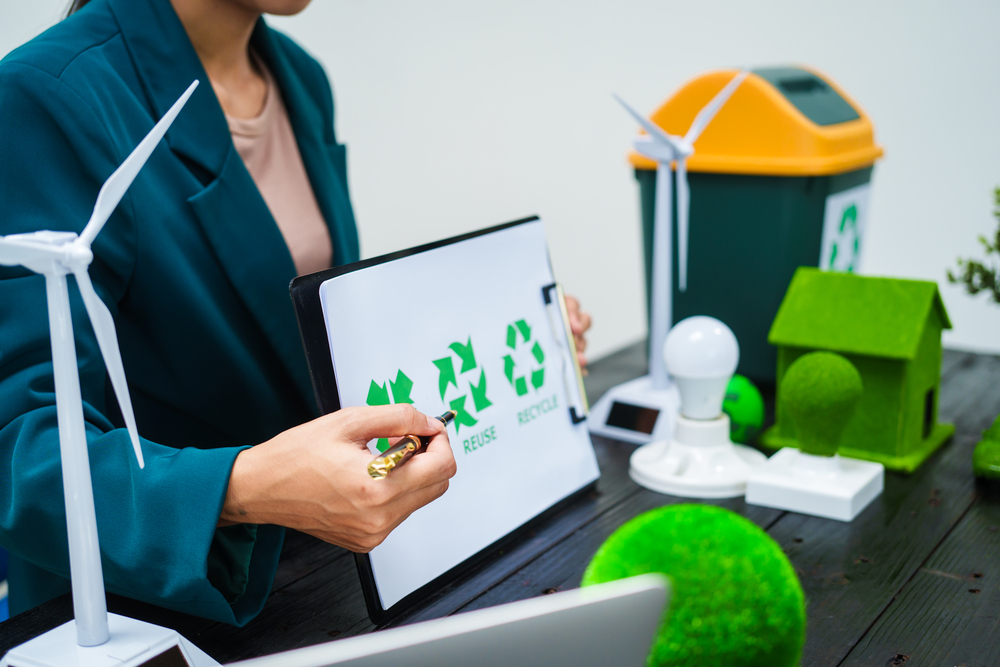
Some
companies are stepping up to address the e-waste challenge. The two most
notable are Apple and Samsung.
In
its 2024 Sustainability Report, Apple announced that 100 percent of the gold,
aluminum, tungsten, and rare earth elements used in its products will come from
recycled metals. Their aim is not just to “use less,” but to establish a truly
circular system where resources can be reused indefinitely.
Samsung’s
“Galaxy Upcycling” project transforms unused smartphones into new IoT devices,
security cameras, or lighting sensors. Rather than letting a phone become
waste, this initiative gives it new life as another useful device.
Additionally,
U.S. startups like TerraCycle and investment firm Closed Loop Partners are
developing AI-powered systems to sort and track e-waste efficiently.
Technologies that turn waste back into resources will be key drivers of the
circular economy moving forward.
▶ Quick summary:
- Global companies such as Apple and Samsung are investing heavily in recycling technologies.
- Upcycling and AI-driven sorting systems are being developed to convert e-waste into resources.
To learn more about green technologies, see: |
―
Ten Actions We Can Take
―
Corporate
and governmental efforts alone are not enough. Individual habits can drive
significant change.
Research
indicates that using a smartphone just one year longer can cut up to 40 percent
of its annual carbon emissions. Before buying a new device, inspect your
current one, and choosing a used or refurbished model is also a great way to
help the environment.
Here
are ten eco-friendly habits even Gen Z can easily adopt:
1.
Use
your smartphone for at least three years.
2.
Buy
a used or refurbished phone.
3.
Donate
unused devices to a recycling center.
4.
Choose
products that can be repaired (check iFixit repair scores).
5.
Support
brands that implement eco-friendly policies.
6.
Only
purchase chargers or accessories when absolutely necessary.
7.
Minimize
cloud storage and delete unnecessary files.
8.
Use
power-saving modes often.
9.
Use
solar chargers or low-power LED products.
10. Dispose of e-waste at
official collection points or certified centers.
To learn more about what we can do for the planet, see: What Is Climate Action? |
―
Small Habits Decide Earth’s Tomorrow
―
The
smartphone in our hand every day is more than just a device. It could become an
Olympic medal, or—if discarded improperly—a source of groundwater pollution.
We
now live in an era where consumers are “leaders with choices.” We decide which
products to buy, how long to use them, and how to dispose of them. The first
step toward protecting the environment starts with the smartphone in your hand
right now.
“Technological innovation must always go hand in hand with environmental protection.”
– Bill Gates
Learn More Global Transition to Sustainable Energy |
Written by: Sharon Choi
Director of Planning
Sunhak Peace Prize Secretariat
References & Sources
Tokyo 2020 Medal Project Final Report
The Global E-Waste Monitor 2020
Greenpeace, “From Smart to Senseless,” 2017
EU Circular Economy Action Plan
EU USB-C Common Charger Policy (Press Release)
Apple Environmental Progress Report 2024

